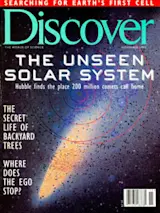For nearly 40 years physicists have had to live with the disconcerting knowledge that the universe favors its left hand. In subatomic interactions involving the weak force--the force of nature responsible for radioactivity--things can happen in one direction but not in the other. For example, all neutrinos formed during radioactive decay spin in the same direction. It’s as if all the tops in the world could only spin clockwise.
Many physicists, however, refuse to believe that the universe was simply born left-handed. They assume that in the first fraction of a second after the Big Bang, the cosmos was ambidextrous, just as it was symmetrical in other ways--for instance, the weak force is thought to have been just as strong as the three other fundamental forces, the strong, the electromagnetic, and the gravitational. The assumption of ambidexterity has been very much an act of faith. But now, thanks to their ...














